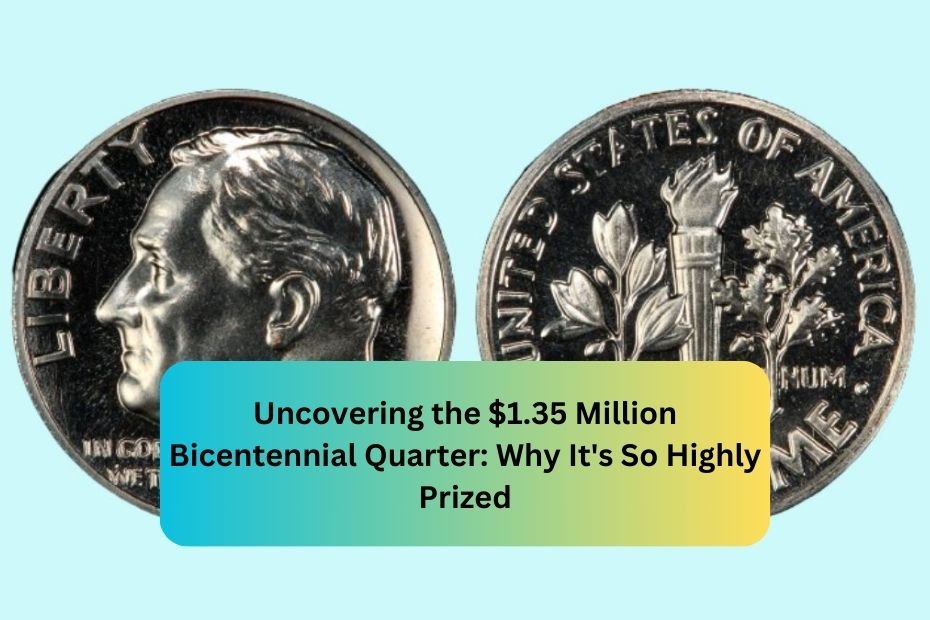The Bicentennial Quarter, minted in 1976 to commemorate the 200th anniversary of the United States, has long been a collector’s favorite. However, a recent discovery involving a rare version of this coin has stirred up tremendous excitement in the coin-collecting world. One such coin was sold at auction for an astonishing $1.35 million, making it one of the most valuable quarters ever. This article explores why this specific Bicentennial Quarter is so highly prized and the factors contributing to its extraordinary value.
The Origins of the Bicentennial Quarter
Commemorating a National Milestone
In 1976, the U.S. Mint issued a special series of quarters to celebrate the country’s 200th birthday. These Bicentennial Quarters were minted from 1975 to 1976 and featured a unique reverse design, differing from the traditional Washington quarter.
- Obverse (Front): Like the standard Washington quarters, the obverse retained the image of George Washington.
- Reverse (Back): The reverse depicted a Colonial drummer boy with a torch surrounded by 13 stars, symbolizing the original colonies.
This design was meant to honor America’s heritage and history during its 200th year of independence.
Availability and Circulation
The Bicentennial Quarters were released in large quantities. Approximately 1.6 billion Bicentennial Quarters were produced at three different mints: Philadelphia (no mint mark), Denver (“D” mint mark), and San Francisco (“S” mint mark). Most of these coins circulated widely and are relatively easy to find in change or in coin collections.
Special Collector’s Editions
Additionally, the U.S. Mint also issued silver-clad proof sets and uncirculated versions of the Bicentennial Quarter for collectors. These silver-clad quarters are rarer than the standard circulation versions and often attract collectors due to their higher silver content and mint quality.
The $1.35 Million Bicentennial Quarter: What Makes It So Special?
So, what makes a Bicentennial Quarter worth $1.35 million? This particular coin stands out due to several unique features that make it one of a kind.
Error Coin: The Key to Rarity
The $1.35 million Bicentennial Quarter is a highly sought-after error coin. Error coins are those produced with mistakes during the minting process, which can make them rare and valuable. While most Bicentennial Quarters were minted correctly, a few unique errors escaped quality control.
- Wrong Planchet: The $1.35 million quarter was struck on a planchet (coin blank) intended for a foreign coin. This error alone significantly increased the coin’s value due to its rarity.
- Unintentional Silver Content: The coin contains a higher silver content than standard Bicentennial Quarters, making it even more precious to collectors.
Mint State and Condition
The condition of a coin is critical to its value. The $1.35 million Bicentennial Quarter was found in mint condition, meaning it had never been in circulation. Coins in such pristine condition are graded by professionals using a scale that ranges from 1 to 70, with 70 representing a “perfect” coin. This Bicentennial Quarter received a high grade of MS-67 (Mint State 67), making it one of the finest known examples of its type.
Auction Sale: Record-Breaking Price
In 2022, this one-of-a-kind Bicentennial Quarter went up for auction and fetched an astonishing $1.35 million. The rarity of the coin, its error features, and its impeccable condition all contributed to this record-breaking price. Collectors were willing to pay a premium for this unique piece of American history.
Factors Contributing to the Value of the Bicentennial Quarter
The Bicentennial Quarter is already a special coin due to its commemorative nature, but several additional factors have contributed to the astronomical value of the $1.35 million example.
Rarity:
While millions of Bicentennial Quarters were minted, the error variety, especially one in mint condition, is incredibly rare. Coins struck on the wrong planchet or with other errors are anomalies that collectors prize highly.
| Factor | Details |
|---|---|
| Minting Error | Struck on a foreign planchet, making it unique. |
| Condition | MS-67 grade, meaning near-perfect mint condition. |
| Rarity | One-of-a-kind error coin, leading to collector demand. |
Collector Demand:
Coins with historical significance, such as those commemorating major events, tend to have strong demand in the collecting community. The Bicentennial Quarter already holds a place in history, and its error variety is even more desirable.
Silver Content:
Silver content in coins often adds value. While most Bicentennial Quarters are made from a copper-nickel clad composition, some versions, including this error coin, contain silver, making them more valuable as both a collectible and a precious metal investment.
| Coin Composition | Standard Bicentennial Quarter | $1.35 Million Quarter |
|---|---|---|
| Materials | Copper-Nickel Clad | Higher Silver Content |
| Mint | Philadelphia, Denver, San Francisco | Unknown (foreign planchet) |
Identifying Valuable Bicentennial Quarters
If you come across a Bicentennial Quarter, you may be wondering if it could be worth a fortune. While the chances of finding a $1.35 million coin are slim, you could still find valuable examples.
Checking Mint Marks and Dates
- No Mint Mark: Quarters without a mint mark were produced in Philadelphia.
- D Mint Mark: Quarters with a “D” were minted in Denver.
- S Mint Mark: Quarters with an “S” were minted in San Francisco and are often proof or silver versions.
Evaluating Condition
- Coins in uncirculated condition or with a high grade (MS-60 and above) are more valuable.
- Look for any errors, such as missing details, double strikes, or planchet irregularities, which can boost the coin’s worth.
Weighing the Coin
- Standard Bicentennial Quarters should weigh 5.67 grams.
- If you believe your quarter is made of silver or struck on the wrong planchet, it may weigh more or less than this standard weight.
Consulting a Professional
To ensure you’re evaluating your quarter correctly, consider consulting a professional coin dealer or sending your coin to a reputable grading service such as the Professional Coin Grading Service (PCGS) or Numismatic Guaranty Corporation (NGC).
Why Collectors Prize Error Coins
Error coins are often the crown jewels of any collection. While regular-issue coins are produced in large quantities, error coins are far fewer, and each error tells a unique story. The $1.35 million Bicentennial Quarter is prized because it’s an accidental masterpiece of the minting process, combining rarity, historical significance, and an intriguing backstory.
- Uniqueness: No two error coins are exactly alike, which adds to their appeal. An error like a wrong planchet or doubled design can turn an ordinary coin into a valuable collector’s item.
- Investment Potential: Error coins tend to appreciate in value over time due to their rarity and desirability among collectors.
Conclusion
The $1.35 million Bicentennial Quarter is a testament to how fascinating and valuable coins can be. With its unique error, mint condition, and historical significance, this coin has captured the attention of collectors and investors alike. While you may not find a multi-million-dollar quarter in your pocket change, understanding the factors that contribute to a coin’s value can help you identify rare and valuable pieces. Whether you’re a seasoned collector or just getting started, the Bicentennial Quarter is a coin worth keeping an eye on.
What makes the $1.35 million Bicentennial Quarter so valuable?
The coin’s extreme rarity as an error coin struck on a foreign planchet, combined with its mint state condition (MS-67), makes it highly prized.
Are all Bicentennial Quarters rare?
No, most Bicentennial Quarters were produced in large quantities and are not considered rare. However, error coins, proof versions, or silver-clad varieties can be more valuable.
What should I do if I think I have a valuable quarter?
If you believe you have a valuable Bicentennial Quarter, consult a coin dealer or send it to a professional grading service like PCGS or NGC for evaluation.
How can I tell if my Bicentennial Quarter is valuable?
Check the coin’s condition, mint mark, and weight. Coins in better condition or those made of silver can be more valuable. Any minting errors will also increase a coin’s worth.
Can I find a valuable Bicentennial Quarter in my change?
While finding a $1.35 million quarter is rare, certain Bicentennial Quarters, particularly silver-clad versions or those in uncirculated condition, can still be worth more than their face value.

